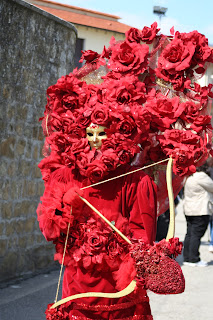Carnival is a worldwide celebration that has an ancient origin. Etimologically, the word carnival comes from the Latin "carnem levare", because it was the abolition of meat which was held just before the period of astinence and fasting of Lent.
The carnival has always been an holiday full of joy where everyone can celebrate with masks, rice and have fun before the fast. The mask is a way to come out from everyday life, to get rid of social roles, to hide oneself in order to become more.
The carnival of Viareggio is a carnival event yearly held in the Tuscan a
city of Viareggio.
Its main
characteristic is given by the parade of floats and masks, usually made of
paper – pulp, depicting caricatures of popular people, such as , showmen
and sportsmen.
The parade is held
on the Viareggio
avenue alongside the local beach; it is a circuit 2 kilometres (1,24
miles) long. Here the floats move along
the spectators, who can attend the show with no barriers, becoming in turn the
protagonists of the parade.
During the carnival
period, Viareggio
change into a true open-air museum, where people coming from all over the world
meet o enjoy together.
The first carnival
parade was held in 1873, when some wealthy middle-class men decided to organize
a parade of floats adorned with flowers.
The official mascot
of the Viareggio
carnival is Burlamacco, first depicted in 1931 by Uberto Bonetti.
Burlamacco is a
clown and he had chosen the red and the white of the outfit from the
traditional colours of the umbrellas on the beach at Viareggio and the name is derived from the
Burlamacca river.
There is a statue
of him all the year round on the Lungomare in Viareggio.
This 140th edition, the parade consists of eight flots of first-class, five of second-, nine masks group and ten isolated ones. Throughout the month the city is transformed into the factory of fun between giant papier-night parties, fireworks, dances, theatrical exhibitions, gastronomic events and major sporting events.
The parades take place: 1-8-15-22 February at3.00 p.m and 28st February at 6.30.
Tickets cost: ordinary ticket € 18.00
Il Carnevale è festeggiato in tutto il mondo ed ha un origine antica. Etimologicamente, la parola carnevale deriva dal latino "carnem levare", perché era l'abolizione della carne, prima del periodo di astinenza e digiuno della Quaresima.
Il carnevale è sempre stata una festa piena di gioia in cui tutti possono festeggiare con maschere, risate e divertimento prima del digiuno. La maschera è un modo per uscire dalla vita di tutti i giorni, per eliminare i ruoli sociali, per nascondersi e per diventare di più.
Il carnevale di Viareggio è un evento annuale che si tiene nella città toscana di Viareggio.
La sua caratteristica principale è data dalla sfilata di carri e maschere, di solito fatti di carta - pesta, raffiguranti caricature di personaggi famosi, come ad esempio, uomini di spettacolo e sportivi.
La sfilata si svolge sul viale lungo la spiaggia locale, si tratta di un circuito di 2 km (1,24 miglia) di lunghezza. Qui i carri si muovono lungo gli spettatori, che possono vivere lo spettacolo senza barriere, diventando a loro volta protagonisti della sfilata.
Durante il periodo di carnevale, Viareggio si trasforma in un vero e proprio museo a cielo aperto, dove le persone provenienti da tutto il mondo si incontrano e si divertono insieme.
La prima sfilata di carnevale si è svolta nel 1873, quando alcuni ricchi borghesi decisero di organizzare una sfilata di carri ornati di fiori.
Per questa 140° edizione, la sfilata dei carri si compone di otto carri di prima categoria, cinque quelli di seconda, nove le maschere di gruppo e dieci quelle isolate. Per tutto il mese la città si trasforma nella fabbrica del divertimento tra giganti di cartapesta, feste notturne, spettacoli pirotecnici, veglioni, rassegne teatrale, appuntamenti gastronomici e grandi eventi sportivi.
Le sfilate hanno luogo domenica 16 febbraio ore 15.00, domenica 23 febbraio ore 15.00, domenica 2 marzo ore 14.50, martedì 4 marzo e domenica 9 marzo ore 15.00
Costi biglietti: biglietto ordinario 15,00 €
Bambini minori di 11anni entrano gratis.









